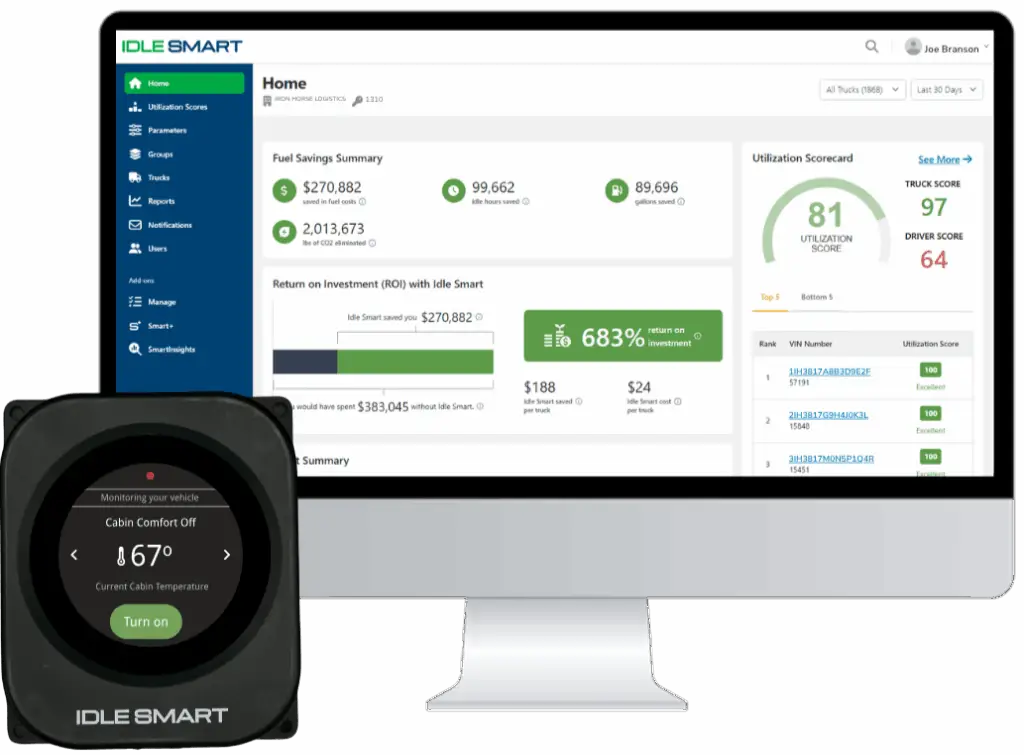For heavy-duty Canadian fleets, winter isn’t just an inconvenience; it’s a recurring threat to profitability. From batteries failing in sub-zero temperatures to diesel fuel gelling and engines refusing to turn over, the risks are everywhere. These incidents aren’t minor hiccups; they are major operational failures that lead to lost revenue and endless headaches for leaders like you.
The question isn’t whether your trucks will face these challenges, but what you’re doing to prepare for them. The smartest fleets are building a plan for operational survival that puts technology to work for them, even on the coldest days of the year.
Here are five ways Idle Smart is helping Canadian fleets master the winter and protect their bottom line.
1. Protection Against the Dreaded No-Start
Getting an emergency call because of a truck failing to start on a frigid morning keeps fleet executives up at night; that’s why Idle Smart is engineered to minimize the risk of cold starts.
- How it works: Our system continuously monitors battery voltage and engine coolant temperatures. When either drops below a pre-set threshold, the system automatically and safely starts the engine to recharge the batteries and warm the coolant.
- The benefit: This automation ensures your fleet is always ready to roll, eliminating the need for costly roadside assistance calls and preventing hours of lost productivity. Idle Smart helps you avoid the financial hit of a no-start, driver frustration, and the logistical nightmare of rescheduling a critical load.
2. A Maintenance-Free Answer to Fuel Gelling
Diesel fuel gelling is a common problem in extreme cold, as the wax in the fuel begins to crystallize, clogging fuel filters and lines. It can stop a truck dead in its tracks. While many fleets rely on fuel additives or manual idling to combat this, Idle Smart offers an intelligent, hands-free solution. The system runs the engine long enough to warm the fuel lines and prevent gelling. Keeping fuel lines clear is especially valuable when drivers are on their rest periods for a day or more; Idle Smart will protect the fuel lines from gelling even if drivers are away from their trucks, ensuring your trucks can start and run reliably every time, regardless of the temperature.
3. Extending Battery Life in Harsh Conditions
Cold weather is brutal on batteries, draining them of power and reducing their lifespan. Idle Smart helps extend their lifespan by keeping them in an optimal state of charge. By automatically engaging the engine to top off the charge, the system prevents the deep-discharge cycles that prematurely wear out batteries. Most systems monitor a battery’s health using a percentage, which is an estimate that can be thrown off by firmware and battery degradation. We provide a more reliable measure by monitoring the actual battery voltage, which is a direct physical property that more accurately reflects the health and charge of your batteries.
Maintenance leaders know that every dollar saved on battery replacements goes directly back to the bottom line. It’s a small change with a massive impact. As one fleet leader put it, “Between the fuel savings and the added battery protection, it’s honestly a no-brainer. The system pays for itself many times over.”
4. A Smarter Alternative to APUs and Excessive Idling
You don’t have to settle for the limitations of outdated technology. APUs can provide comfort and power, but they come with a steep price tag, significant weight, and a constant need for maintenance and repairs. Manual idling, while common, is an inefficient and expensive way to keep a truck warm. With Idle Smart, you get a maintenance-free, lightweight system that installs in about an hour and provides instant fuel savings. Plus, unlike APUs that require replacement every 3-5 years, Idle Smart lasts for the life of your truck.
The system’s intelligent engine control keeps the cabin at a comfortable temperature without excessive idling or incurring high costs. Using maintenance-free solutions like Idle Smart frees up technicians from constant “firefighting,” which is critical as the industry is faced with an ongoing technician shortage. In a demanding market, tools that drive this kind of efficiency are a competitive advantage that keeps the most talented technicians on your team.
5. Data and Control from the Comfort of Your Office

Knowledge is power, especially when it comes to managing a fleet in the winter. Most APUs don’t provide data, and those that do often have a fairly limited scope. Our SmartPortal platform gives you visibility into your entire fleet’s idling behavior, regardless of OEM; it provides unprecedented control over your fleet’s efficiency right from your desk. You can see how the system is working and adjust parameters for a single truck, a group, or your whole fleet to maximize your fuel efficiency. See who is using the system most effectively, establish coaching opportunities, track your fleet’s fuel savings, and get actionable insights into potential maintenance issues.
Winter Is Coming. Are You Ready?
Winter will always be a challenge for Canadian fleets, but the right technology can transform it from a period of operational stress into a time of predictable efficiency.
Ready to winterize your fleet’s operations and protect your bottom line?
Schedule a no-risk consultation to learn how Idle Smart can prepare your fleet for anything Mother Nature throws at it.
